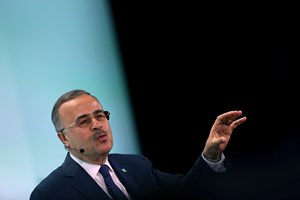World oil demand outpacing expectations, challenging peak crude predictions
(Bloomberg) – The world is using more oil than ever and demand is outpacing expectations again this year, raising questions about how soon global consumption will peak.
The unabated thirst for crude contributed to an increasingly confident tone from executives at this year’s CERAWeek by S&P Global conference, the industry’s annual get together in Houston, America’s energy capital. Many attendees who spoke in interviews or on stage at the event this week said they expect consumption to rise for many years to come.
“We should abandon the fantasy of phasing out oil and gas,” said Amin Nasser, the chief executive officer of Saudi Aramco, the world’s largest producer. Instead, we should “invest in them adequately, reflecting realistic demand assumptions, as long as essential,” he said in a speech applauded enthusiastically by attendees.
Key speakers at CERAWeek 2024. Russell Hardy, the CEO of Vitol SA, the biggest global oil trader, told the conference his firm was pushing back the estimated peak in oil consumption to the early 2030s because of downgraded expectations on the adoption of electric vehicles.
The International Energy Agency forecasts oil demand will rise 1.3 MMbpd in 2024. While that’s less than last year’s jump of 2.2 MMbpd, when China’s emergence from Covid restrictions juiced consumption, it’s still healthy by historical standards.
The agency, which has had to raise its forecasts several times, now expects daily demand to average a record 103.2 MMbbl this year. It points to the strength of the U.S. economy and the extra distance sailed by ships avoiding the Suez Canal as drivers of demand.
But many in the industry think the IEA, which expects global demand to peak before the end of the decade, is too conservative both in the short- and medium-term.
Oil trader Gunvor Group expects an increase of 1.4 MMbpd this year. Trafigura, another global merchant, says the consensus expectation is about 1.5 MMbpd, but argues there are considerable upside risks to that forecast.
“The U.S. economy, in particular, has surprised to the upside,” Saad Rahim, Trafigura’s chief economist, said in an interview. “Oil demand is performing better than expectations.”
The strength of consumption has helped to drive a rally in oil prices — benchmark Brent crude oil futures have risen 11% this year, at one point trading at more than $87 a barrel.
There are areas where demand is especially robust — the rerouting of ships away from the Red sea alone has added 100,000 bpd to global demand, according to Vitol. Jet fuel and plastics are also strong drivers.
India is also set to be a major contributor of additional usage. Its government expects the economy will expand 7% in the fiscal year beginning April, making it one of the fastest-growing major economies. The world’s third-biggest oil importer behind China and the U.S., India is set to be the single largest source of global demand growth between now and 2030, according to the IEA.
“Oil demand has stayed very strong, both in the U.S. and in other countries, both developed countries and emerging markets,” said Helen Currie, chief economist at U.S. oil producer ConocoPhillips. “We’re looking for another record high in world demand this year across the board.”
Until the link between economic growth and rising demand for gasoline, diesel and other oil products can be broken, a peak in crude consumption is likely to remain elusive.
The rise of EVs at the expense of internal combustion engines will be the biggest drag on oil demand in coming years, especially in China. But research from BloombergNEF forecasts EV sales growth will slow in coming years, while the total stock of gasoline- and diesel-powered vehicles continues to rise.
“We see demand increasing throughout this energy transition,” Sheikh Nawaf Al-Sabah, CEO of Kuwait Petroleum Corp., said this week, explaining why the Middle East nation plans to expand oil production capacity.



